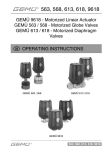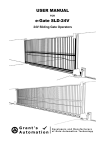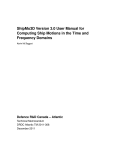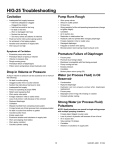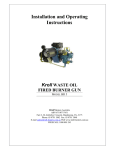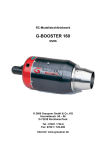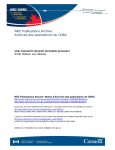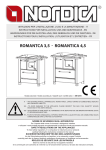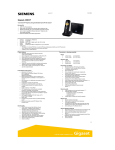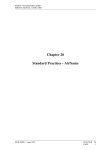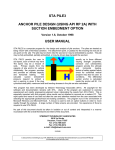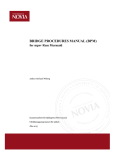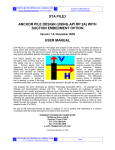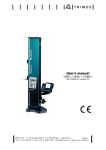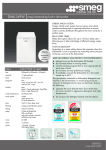Download Storm Cove - Marine and Safety Tasmania MAST
Transcript
Marine and Safety (Maritime Incidents) Regulations 2007 Investigation into “MT Storm Cove” Machinery Damage At Macquarie Wharf 2/3, Hobart, Tasmania On 31 December 2012 FOREWARD Investigations into maritime incidents occurring within the jurisdiction of Marine and Safety Tasmania (MAST) are conducted in accordance with Part 3 of the Marine and Safety (Maritime Incidents) Regulations 2007. Investigation reports are endorsed by the Board of MAST prior to publication. It is MAST policy to publish investigation reports to increase awareness of maritime incidents and improve safety at sea. Copies of this report can be obtained from: Marine and Safety Tasmania 5 Franklin Wharf Hobart 7000 www.mast.tas.gov.au (Publications) CONTENTS 1. Summary Page 4 2. Sources of Information Page 5 3. Vessel Certificate of Survey Page 5 4. The Vessel Page 6 5. Narrative Page 7 6. Analysis Page 8 7. Comment Page 9 8. Conclusions Page 9 9. Declarations of Interest in current investigation Page 10 Page:- 3 of 10 Report No. 13002 MT "Storm Cove" Machinery Damage December 31 2012 THIS IS TO CERTIFY that at the request of the Chief Executive, Marine and Safety Tasmania, the „Investigator‟ did attend on board the MT “Storm Cove” afloat at the Domain Slip, Hobart, Tasmania on 8th January 2013 and subsequently to investigate and report upon the circumstances surrounding damage to the vessel's Port Main Engine that occured during berthing operations at the port of Hobart, Tasmania on December 31 2012. SUMMARY On Thursday December 31st. 2012 at approximately 0718 (local time) the MT "Storm Cove" was assisting to berth the Cruise Vessel "Costa Neo Romantica" at Macquarie Wharf 2/3 Hobart. Due to forecast high winds two tugs had been ordered by the attending Pilot and were assisting to berth the vessel starboard side alongside the berth. Winds were NNW 15-25 knots with gusts to 35 knots, tending to blow the vessel off its intended berth. The "Storm Cove" was lashed up to the "Costa Neo Romantica" port shoulder at approximately 0653 hrs and as the "Costa Neo Romantica" was experiencing side drift of approximately 1.5 knots, both tugs were ordered by the Pilot to push up at full power. At approximately 0718 hrs a "poof" sound was heard by the Master and Engineer on the tug, at the same time smoke was noted emanating from the tug engine room vents and the engine room fire/smoke detector alarm activated. The Engineer made his way from wheelhouse to engine room and after gaining access to the engine room noted the vessels Port Main Engine (PME) crankcase pressure relief doors were lifting. The engine was immediately stopped at 0721. The "Costa Neo Romantica", initially after the loss of 50% of the 'Storm Cove" power started blowing further off the berth. Forward breast lines were run, by the attending linesboat to assist and due to a slight easing of the wind the vessel was made fast to the wharf securely. Page:- 4 of 10 SOURCES OF INFORMATION Tasports Pilotage Incident Report (dated 31/12/2012) Tasmanian Ports Corporation Incident/Accident Report Form (dated 31/12/12) MAST Incident Report (dated 31/12/12) Vessel Survey Certificate Engine Operating Manual Ship visit Interview with Engineer Interview with Fleet Superintendent VESSEL CERTIFICATE OF SURVEY Identifying No. 000045 Measured Length:- 28.73m Beam;-7.73m Depth:- 3.44m Propulsion:- 2 X 708Kw diesel engine Class:- 2D Minimum Crew:Master Class 4 Marine Engine Driver Grade 1 1 GP For voyages exceeding 12 hours one crew member other than the master to hold a Master Class 5 Certificate or higher and will be the designated watch keeper. Adequate Crew As for minimum crew Class:- 2B Minimum Crew:Master – Master Class 4 Mate – Master Class 5 Engineer – Class 3 1GP Due Date Next Periodical Survey:- 11 April 2013 Page:- 5 of 10 THE VESSEL "STORM COVE" 223 Gross Tons is a welded steel twin screw tug built Carrington Slipway, NSW, 1971 and purchased by present owners during 2007. The vessel is fitted with twin Daihatsu make 8 cylinder 4 stroke turbo charged trunk piston diesel engines, type 8PSLH TBX2M-26D of 280mm bore X 320mm stroke developing 708 Kw HP @ 750 RPM built April 1970. Each engine is direct coupled (via clutch) to a "Duckpeller1000" azimuthing propeller unit. The "Duckpeller 1000" Azimuthing Propeller is a combined propulsion/steering unit intended to provide independent propulsive power and steering to each of the vessels engines. The vessel is fitted with a forward mounted towing winch with operating controls in wheelhouse and port forward main deck. Since 2005 the vessel, for 2D harbour operations has been manned with a three man crew:- Master. Engineer and GP hand. The Engineer's normal station and duties for berthing operations is in the wheelhouse operating the towing winch. The vessel's wheelhouse is fitted with limited main engine, generator, electrical and propulsion alarm repeaters (audible and visual) and an alarm repeater strobe light and audible alarm is fitted outside the wheelhouse forward. Display of various engine temperatures and pressures is only available in the machinery control room (in the engine room) and locally at the engines, there are no means provided in the wheelhouse for monitoring any main engine operating parameters. The engine alarm klaxon located in the engine room is audible in the wheelhouse. In respect of main engine alarms the wheelhouse repeater alarm panel is fitted with a single alarm light for each main engine marked "Engine Lub. Oil". Each of these alarms serve a dual purpose, the same alarm light and associated horn for either engine being activated in the event of:a/. High jacket water temperature or b/. Low lubricating oil pressure The "High Jacket Water Temperature" alarm is activated when an adjustable temperature sensor fitted in the respective main engine jacket cooling water return rail reaches its setting. The "Low Lubricating Oil Pressure" alarm is activated when an adjustable pressure sensor fitted in the respective engine lubricating oil gallery reaches its setting. In the case of a "High Jacket Water Temperature" alarm activation it is a visual and audible indication of a respective engine jacket water reaching a high enough temperature to activate the alarm. In the case of a "Low Lubricating Pressure" alarm activation it is a visual and audible indication of a respective engine lubricating oil pressure reaching a low enough pressure to activate the alarm, should the lubricating oil pressure continue to fall each engine is fitted with a device that immediately this pressure is reached it shuts the engine down. The vessels main engines are fitted with individual cylinder jacket cooling water return flow Page:- 6 of 10 regulating cocks (valves) to balance the flow (and therefore temperature) of each cylinder jacket cooling water, each outlet being originally fitted with individual thermometers, none of which are now fitted/operational. In the past 12 months adjustments had been made to some individual engine cylinder jacket cooling flows by means of partially closing their cocks to balance their outlet temperatures with the aid of a hand held distance reading thermometer. The adjustment of individual cylinder jacket cooling return flows is noted in the engine operating manual but no specific procedures are described. Maximum engine operating temperature noted in engine operating manual is 80ºC, normal operating temperaures are between 50 and 70ºC. The main engine crankcases are fitted with Explosion Relief Valves to release excessive crankcase pressure in the event of a crankcase explosion. A crankcase explosion can occur when a "hot spot" (overheated metal part(s) or piston blow by) vapourises some of the lubricating oil within the crankcase. The vapourised oil circulates to cooler parts of the crankcase where it condenses to a white mist of finely divided oil particles mixed with air (oxygen) present within the crankcase. This mist is combustible within certain concentrations. If the mist should circulate back to the hotspot in such concentrations it will be ignited and a primary or minor crankcase explosion will occur. The severity of any explosion can be as little as lifting crankcase relief devices or should air be drawn back into the crankcase development of a secondary explosion usually of far greater severity than the primary and capable of causing major structural damage to the engine (and surrounds) can occur. NARRATIVE Prior to the initial indication of noise, smoke and alarm sounding both vessels main engines had been operating for approximately 30 minutes at full power. On gaining access to the engine room after the initial indication the Engineer noted: Both main engines were still operating at full power. The PME jacket cooling water return rail temperature was 82ºC All other temperatures and pressures appeared normal (cylinder exhaust gas temperatures were not able to be easily noted). The PME crankcase explosion relief doors were lifting. The PME was immediately shut down. The Engineer then vacated the engine room to allow suspected heated engine parts to cool and remaining smoke to dissipate. On return to the engine room the PME sump level was noted to have increased and engine jacket cooling water was draining into the engine sump from the PME No.2 cylinder liner "o" ring seals. The vessel returned to her berth under her own power. Following initial investigation it was noted that the PME No.2 cylinder liner jacket cooling “o” ring seals had failed and jacket water was leaking into the engine sump. Page:- 7 of 10 The PME No. 2 piston and liner were withdrawn. The piston and cylinder liner showed distinct evidence of overheating, scoring and partial siezure, all piston rings with the exception of the lower scraper ring were seized within the piston ring grooves.. The upper two of three cylinder lining "o" ring seals were in poor condition, the lower showed distintive evidence of heat associated deterioation. Tests conducted on various engine alarms and indicators revealed that the PME jacket cooling water return rail high temperature alarm sensor was activating at approximately 88ºC, the SME was inoperative, (Maximum jacket cooling water temperature noted in engine operting manual is 80ºC.) The PME jacket cooling water return rail thermometer indicated accurate temperature. Following repairs to the PME the vessel undertook a full power push up trial on 7th. February 2013 but the PME and to lesser extent the SME showed indication of significant overheating before the trials could be completed. Following repairs/maintenance of main engine jacket cooling water heat exhangers and associated engine cooling pipework successful trials were completed on 21st. February 2013. ANALYSIS The proximate cause of the failure was the overheating and partial seizure of the PME No.2 piston and cylinder liner. The overheating was caused as a result of a combination of fouling of jacket cooling water heat exchanger and defective and partially blocked isolating valve(s) within the jacket and sea water cooling water circuits. The overheating of the PME No.2 cylinder was exacerbated by the lessened cylinder jacket cooling water flow to the No.2 cylinder following adjustments to its return flow. The “poof” sound noted at the time of the failure was most likely the initial lifting of the Crankcase Relief Valves as a result of a minor crankcase explosion, the “hot spot” in this case being either overheated piston and or cylinder liner and or piston blowby caused as a result of seized piston rings. The doors continued to lift until fuel was shut off to the engine as the PME No.2 cylinder products of combustion bypassed the seized piston rings into the crankcase. The leaking of cylinder jacket cooling water into the engine sump was as a result of the lower "o" ring seal failing due to overheating. Page:- 8 of 10 COMMENT The adjustments to both engines cylinder jacket cooling water return flows had been carried out at the vessels free running speed of approximately 600 RPM (the engines being only partially loaded) and not at full "push up" engine loads of 750 RPM. It is not the practise of the vessels owners to carry out engine trials at full power following adjustments to various engine systems such as fuel and cooling systems. The PME Jacket Cooling High Temperature alarm was set at approximately 88º C, had this alarm been set at (say) 75ºC then it is most likely that the vessels Engineer would have been alerted to a higher than normal jacket cooling temperature and been able to take steps to avert the overheating by slowing or stopping the PME before damage ensued. Maintenance records available on the vessel are incomplete however it appears the PME No.2 cylinder and liner were last overhauled in 2005. The engine operation manual although not specifying an overhaul period in either operating hours or passage of time for engine cylinder liners "recommends" that the cylinder liners are removed at least once in four (4) years for inspection of any corrosion and cleaning. Testing of correct operating paramaters for various engine, electrical and propulsion alarm systems had been regularly carried out but in the case of the jacket cooling water high temperature alarms correct set point operation had not been verified as this test requires the sensor unit to be removed from the return rail and its operation verified using heated water and comparison thermometer. Maintenance records of both engine heat exchanger tube cleaning were incomplete and it is unknown when the heat exchangers were last serviced. Some of the isolating valves fitted within both engine jacket and sea water cooling circuits are of a type that relies on a rubber type material diaphragm for their operation, over time some diapragms had swollen and parly choked the flow of water through the valve although the valve operating mechanism indicated the valve was fully opened, this choking of cooling water flow was not readily identified with existing engine monitoring instruments. CONCLUSIONS These conclusions endeavour to identify factors which may have contributed to the incident and should not be read as apportioning blame to any particular individual or organisation. 1/. It is considered that as a minimum the following should be provided in the wheelhouse:a/. Individual Main Engine jacket cooling water temperature indication as well as high temperature alarm. b/. Individual Main Engine lubricating oil pressure indication as well as low pressure alarm. c/. Jacket Cooling Water Header Tank low Level alarm. Page:- 9 of 10 2/. It is considered that the main engine individual cylinder cooling return thermometers should be re-instated. 3/. It is considered that full power engine trials for a minimum period of time of 30 minutes should be undertaken following any adjustments to critical main engine systems. All engine operating temperatures and pressures to be recorded and retained. 4/. It is considered that isolating valves of the rubber diapragm type fitted to the engine jacket and sea water cooling circuits be serviced or replaced with suitable mechanical type valves 5/. It is considered that service and overhaul of various main engine components should be undertaken strictly in line with engine service manual recommendations and full records maintained 6/. It is considered that full power engine trials for a minimum period of time of 30 minutes should be undertaken on an annual basis. All engine operating temperatures and pressures to be recorded and retained 7/. It is considered that proving of operation of all engine, electrical and propulsion alarms, including sensor units be undertaken on a quarterly basis. DECLARATION OF INTEREST IN CURRENT INVESTIGATION This investigation has been carried out by the undersigned concurrently with a similar investigation carried out for the vessels Hull & Machinery underwriters. Hobart, Tasmania 22nd. February 2013. Page:- 10 of 10










